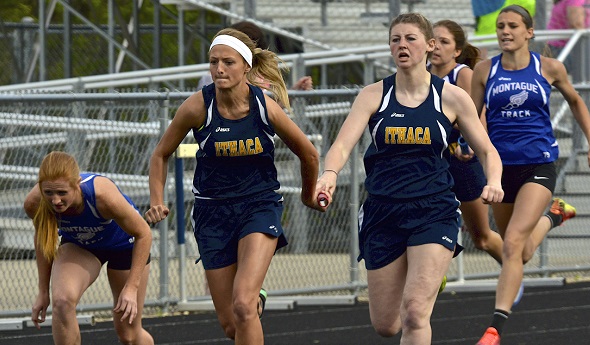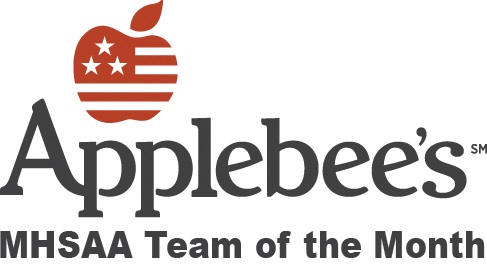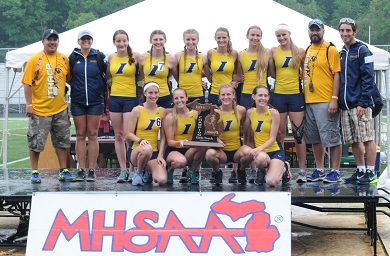
Coach Predicts Title, Ithaca Girls Answer
June 13, 2016
By Geoff Kimmerly
Second Half editor
There’s a clear difference between prediction and expectation. But the Ithaca girls track & field team had to decide which way coach Gene Lebron was leaning when he told his athletes they’d win an MHSAA championship this spring.
 Erica Sheahan knew it was more than a pep talk.
Erica Sheahan knew it was more than a pep talk.
Lebron had called his cross country team’s 2014 championship as well – and that gave this spring’s Yellowjackets plenty of faith in their coach’s fearless forecast.
Ithaca’s girls track & field team – the Applebee’s Team of the Month for May – dominated its Tri-Valley Conference West competition at last month’s league meet and also won its Division 3 Regional for the second straight year – and second time total in program history.
and it’s impossible to overlook what the Yellowjackets then accomplished four days after May ended – win the first MHSAA Finals championship in program history, scoring 57½ points to edge Adrian Madison by 3½ at the Lower Peninsula Division 3 meet at Comstock Park.
“This group of seniors, we accomplished a lot together and we set our goals high,” said Sheahan, who repeated as LP Division 3 long jump champion. “Coach told us this would be the year, and we stuck to it and did the best we could to make it happen.”
At the MHSAA postseason level, that first step came at the May 20 Regional at Shepherd, which Ithaca won by 52 points over the runner-up Bluejays. The Yellowjackets then won their league meet on May 25 with 215 points, doubling up the field while finishing first in seven individual races, two field events and all four relays.
Ithaca also started May with a 12½-point win at the Shepherd Invitational over Cadillac, which went on to tie for 17th in LP Division 2 this month, and third-place Fowler, which won the LP Division 4 championship. Ithaca also won the Division 3 portion of the Alma College Scottie Classic on May 14.
By the end of this season, Ithaca had broken school records in every relay, long jump, the 200, 800, 1,600 and 300 hurdles. Lebron said the relay records might not be approached for some time.
“Those records were already set really high, and these girls really performed at a high level this year,” Lebron said. “They really took a stride.They fed off that (2014) championship in cross country. We sent 10 girls to the MHSAA state meet, and six of those girls ran at the (cross country) state meet when we won. When we won in 2014 in cross country, we came back that track season and placed fourth. They kinda knew the writing was on the wall.
"They were disappointed with the state meet in cross country this year; they finished fifth and I thought they should’ve been higher, and they did too. They felt they let one get away, but they came in more motivated than ever for track.”
Sheahan was the only Ithaca girl to win a Finals championship. But she also won the 100 and 200 at the Regional, where junior Courtney Allen won the 800, junior Emily Foster won the 300 hurdles, and some combination of Sheahan, Foster, Allen, Mikayla Fairchild, Kara Kindel, Morgan Most, Blaire Showers, Amelia Freestone, Kurstin Kalisek and Alyssa Mankey won all four relays.
 Counting every team Ithaca finished ahead of at an invitational or postseason event, the Yellowjackets were an incredible 145-2 this season, finishing third at the Michigan Interscholastic Track Coaches Association meet but winning every other time they competed.
Counting every team Ithaca finished ahead of at an invitational or postseason event, the Yellowjackets were an incredible 145-2 this season, finishing third at the Michigan Interscholastic Track Coaches Association meet but winning every other time they competed.
Lebron has been around plenty of championship teams. In addition to his, Ithaca is best-known for its football team that’s won five of the last six Division 6 titles. He sees every day the sacrifices made by athletes hoping to reach the highest level.
But to him, the level of commitment by the girls on this spring’s team still stood out. Some played volleyball in the past, but switched the cross country to better prepare for track season. As a team, they lifted weights during the offseason three times a week at 6:30 a.m., and informally the distance runners and some sprinters would get together every Sunday for a long run.
Equally “extraordinary,” the Yellowjackets have a cumulative grade-point average of 3.755.
Indeed, football does enjoy most of the statewide shine for the community of 3,000 about 45 miles north of Lansing. But the girls running program has made a reputation as well the last two school years.
“They’re diehard with football. They’re all friends with those guys. But they want their own success,” Lebron said of his athletes. “Every team at Ithaca lives in the shadow of Ithaca football. But I don’t think that’s a negative thing all together. I think our girls are motivated by them. We’re going to cast our own shadow.
"Football is football; it’s America. But these girls have done a good job making a name for themselves.”
Past Teams of the Month, 2015-16:
April: Lake Orion boys lacrosse – Report
March: Hancock ice hockey – Report
February: Petoskey boys skiing – Report
January: Spring Lake boys swimming & diving – Report
December: Saginaw Heritage girls basketball – Report
November: Ann Arbor Gabriel Richard volleyball – Report
October: Benton Harbor football – Report
September: Mason and Okemos boys soccer – Report
PHOTOS: (Top) A pair of Ithaca runners complete a handoff during their Regional meet May 20 at Shepherd. (Middle) The Yellowjackets pose with the first MHSAA Finals championship trophy won in program history. (Click to see more from HighSchoolSportsScene.com.)

Hastings Relays Reigns as State's Oldest Continuous Track & Field Meet
By
Steve Vedder
Special for MHSAA.com
April 10, 2024
Bob Branch remembers dabbling in other sports, but his first love was always running.
 The Hastings High School graduate admits he could never hit a baseball, football didn't especially appeal to him and basketball was just another way to spend time with friends. But for Branch, now 93, there was always track. That's the sport where his fondest and sharpest memories remain. And if you're talking track, many of his favorite memories come from participation in the state's oldest continuous track meet, the Hastings Relays.
The Hastings High School graduate admits he could never hit a baseball, football didn't especially appeal to him and basketball was just another way to spend time with friends. But for Branch, now 93, there was always track. That's the sport where his fondest and sharpest memories remain. And if you're talking track, many of his favorite memories come from participation in the state's oldest continuous track meet, the Hastings Relays.
Always held in early April, the meet dates back to 1937 – a bygone time that saw the first hostilities of World War II, gas at 20 cents a gallon and a loaf of bread selling for a dime.
And at a dusty old track surrounding the county fairgrounds in Hastings, a small relay event that included a scattering of participants from a dozen high schools was taking its first tentative steps.
Branch recalls a time when kids would run home after track practice because there were no buses, inexperienced young coaches had little actual knowledge of running fundamentals, and athletes looked at the sport as an afterthought after spending most of their high school days playing football and basketball.
 For Branch, the relays were the ideal way to ease into the track season.
For Branch, the relays were the ideal way to ease into the track season.
"I just liked to run," said Branch. "I remember I anchored a relay with my brother, and it always seemed cold when we had that meet. I remember teams would come from all over and you saw a lot of good athletes. Everybody seemed to have someone who was really good. Track wasn't very popular at that time, but I have a lot of good memories from running."
The Hastings Relays, which has changed formats and even names during its nearly nine-decade history, would traditionally kick off the track season. The meet was originally held at a makeshift quarter-mile track which surrounded the town's fairgrounds and was part of the city's annual Hastings Carnival – the track would become the midway during fair time.
The meet eventually moved to Johnson Field when the football field was dedicated in 1949 and ballooned to as many as 50 teams at its peak in 1957. For more than seven decades it was known as the Hastings Relays and then the Hastings Co-Ed relays before becoming the current Hastings Invitational, with the latest edition scheduled for Friday.
Johnson Field had a cinder track before it became an all-weather surface in the 1980s. During a time long before computers would be used to organize meet heats in mere minutes, Hastings coaches of all sports – defined as "volunteers" by the athletic department – would meet on the Friday before competition to hash out events.
People associated with the meet still recall the camaraderie built on those long Friday nights, followed by working what would often become 10-hour meets. Steve Hoke has been involved since watching his father, Jack, who coached teams at 15 of the meets beginning in 1951 and also had run in the first Hastings Relays. Steve Hoke later competed in the Relays as well during the early 1970s before becoming an assistant track coach, later the Hastings athletic director and now a volunteer worker.
"It was always a huge deal," said Hoke, who said the meet began as a pure relay event before transitioning to its current team format in the 1990s. "I remember we'd line the track the night before, and all the coaches would come to the house to organize everything. There was a brotherhood.”
 If you quiz many of the fleet of volunteers who've worked the relays over the years, each has a different memory from the meet. While Hoke describes the brotherhood and Branch the outstanding competition, others remember weather and the time a thunderstorm wiped out the line markings on the cinder track, or waking up to find three inches of snow that caused a rare cancellation of the meet. Others recall the shock of moving from the cinder to all-weather track or using the meet as an early measuring stick of what it would take to qualify for the state meet. The real old-timers remember the meet disappearing for three years during World War II.
If you quiz many of the fleet of volunteers who've worked the relays over the years, each has a different memory from the meet. While Hoke describes the brotherhood and Branch the outstanding competition, others remember weather and the time a thunderstorm wiped out the line markings on the cinder track, or waking up to find three inches of snow that caused a rare cancellation of the meet. Others recall the shock of moving from the cinder to all-weather track or using the meet as an early measuring stick of what it would take to qualify for the state meet. The real old-timers remember the meet disappearing for three years during World War II.
Hastings native and Western Michigan grad Tom Duits was the state’s second collegian to break the four-minute mile when he ran a 3:59.2 at a meet in Philadelphia in 1978. Duits, who ran in three Hastings Relays, was in line to join the U.S. Olympic team in 1980 before the United States pulled out of the games due to tension with Russia.
Duits has his own memories of the meet and the competition he faced there.
"I remember sunshine and being excited to be competing again. There were all these athletes swarming around; it was an awesome display of talent," he said. "It was always one of the best meets we'd be in. You could pretty much see the level of runners who would be at state, which made it a big deal. It was always early, but you could tell where you stood. It was great exposure."
Hastings track star Wayne Oom competed in four Hastings Relays from 1984-87. One of his sharpest memories was the difference between running on a raw cinder track versus the far more comfortable all-weather surface.
"Those cinders would grind into your skin," said Oom, part of the Hastings school record in the two-mile relay. "But I think it helped us because when we'd go to other tracks, it seemed we would run faster. I remember how competitive it was, especially in the distances. There were some great runners."
While participants have their unique memories, so do coaches. Former Saxons coach Paul Fulmer remembers 2008 when his team finished first on the boys side of the meet while his wife, Grand Haven coach Katie Kowalczyk-Fulmer, saw her girls team win the championship.
 "I knew we were one of the favorites to win because we were usually near the top of our conference and Regional," he said. "But then Katie's team was pretty good, and it was cool for them to win too."
"I knew we were one of the favorites to win because we were usually near the top of our conference and Regional," he said. "But then Katie's team was pretty good, and it was cool for them to win too."
Fulmer, who coached Hastings from 1978-81 and then 1985-2010, said at least part of the meet's popularity was derived from a unique way of scoring. Instead of individuals earning points solo, participants worked in pairs. For instance, two athletes would combine their shot put or long jump scores. New events such as the 1,500 relay and sprint medley were added.
"We had a tradition of being the state's oldest meet, and that was a big deal," Fulmer said. "And we ran a good relay; that attracted teams too. We took a lot of pride in that.
"And we'd get quite a lot of people to come to the meet. We'd set up until like 9 or 10 p.m., and then we'd have a party with all the coaches on Friday night."
While the meet has stretched 87 years, Branch said early participants and current runners have one thing in common: a drive to win. Branch ran in an era when the popularity of high school track was in its infancy. Today some of the best all-around athletes at a school are involved in the track program. The relays span the nearly nine decades in between.
"The quality of teams has gotten better and better," said Branch, the 1947 Lower Peninsula Class B Finals champ in the 220. "And this has made for a better meet. We would get guys who played football or baseball kind of drift into track, and that made the sport better. I think people began to appreciate track because we'd get teams from all over.
"We went from not really knowing what we were doing to track being a good sport. Even then, I'm not sure we appreciated what we had. We really liked the Hastings Relays and always wanted to do well there. It became popular and quite an honor to do well. Those are the kind of things I remember."
PHOTOS (Top) Racers run at the Hastings Relays, with several more awaiting their turns to compete at the longtime meet. (2) The author wrote on the 50th anniversary of the Relays for the Hastings Banner nearly 40 years ago. (3) Past athlete, coach and athletic director Steve Hoke shows some of the Relays awards from the 1930s. (4) Tom Duits was one of the state’s biggest track stars of the 1970s and ran in three Hastings Relays. (Top photo by Dan Goggins, Hoke photo provided by Steve Hoke and Duits photos provided by Tom Duits.)

